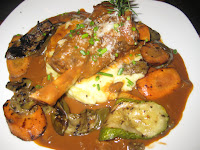When we got back to our inn after the tiring trek to and from Batad Village and Tappiah Falls (April 4), we sat around a little on our balcony. That's when I remembered that we didn't look around the village. The guide--Pio--had told us the day before that he was going to tell us folklore, etc. when we're in the village. Since he didn't do that, I had him tell us stories right then.

We asked why traditional huts don't have windows. He said that it's to keep warm in the mountains, but also because they dry their grains in their huts (in the upper part of their huts, close to the roofs). Having windows would bring in cold air, and the grains would not dry correctly. Another reason may be (and this is said to be the reason these huts are on stilts) is so that the enemies would have a hard time entering. I've heard that, at night, they pull up their ladders and close their doors behind them.

Having stayed in a neo-traditional hut, I can't imagine staying in there without windows. It can get stuffy and claustrophobic. But I guess that's the point. People probably worked most of the day in the fields and went home to sleep. Or, if they were home, they probably did what I've seen present-day folks doing--which is to hang out in the stilt area under the huts.

We also asked why there some of the huts in the village are not made the traditional way--that is, they have tin roofs instead of grass. He said that people want to do it the easy way. They don't want to go trudging to the other mountains to get the grassy material when tin is so much easier to obtain and use. As someone who likes to maintain their traditions and sees that tradition as a tourist attraction, he lamented this sort of thinking.

We asked how the terraces came to be. Pio said that, according to his grandmother, the story goes like this: A couple of thousand years ago, there were two friends who lived in a village on the other side of the mountain. They came to this side of the mountain (where Batad is), and they made the first terrace on their own. They thought it was a good place to live, so they told the other villagers to come, too. The other villagers came, and they built the rest of the terraces. Pio said that tourists would often say that there must be concrete holding the stones together, but he always tells them to look closely. While there are a few concrete areas, those were put in more recently and are only on walking paths.
We asked about the
hudhud, which are Ifugao chants or songs that are performed during harvesting, wakes, and other rituals. The
hudhud tells of their folklore--heroes, culture, values--and can take 3 or 4 days to perform. It has been recognized by UNESCO as an "
oral and intangible masterpiece." We asked if there was a specific time when people could witness the
hudhud, but Pio said that the planting and harvesting are in turns, so they take weeks to finish. Women may sing the
hudhud at any of these times, so there is not a date that one can necessarily pinpoint.
We asked about the planting. Pio said that one family--the one that owns the most terraces (right at the center of the village)--always starts the planting season. I believe he said that the man consults the
mumbaki (Ifugao priest or medicine man) prior to the planting season or just after the last harvest about when would it would be best to start planting. The
mumbaki also tells him what (animal) sacrifices he needs to make prior to planting. So, this ritual starts off the planting season, and each family in turn can plant their terraces. This family is also the first to harvest, and they have feast for the whole village.
We asked a few other questions, but this is what I remember. I hope I remembered them correctly.






























































